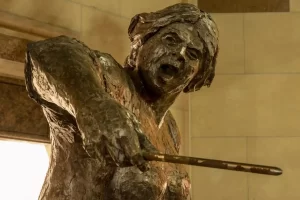Jefferson: The Most Haunted Town in Texas

Jefferson is a small town in East Texas, not too far from the Louisiana border. This quaint little town was once a central trading hub between the South and the Midwest but has since faded into oblivion. Since then, Jefferson has become an eerie place, now known as the most haunted town in Texas. It seems like every other establishment in Jefferson has a few ghost stories. The major hotels in the town are both haunted, so if you’re spending the night in Jefferson, you’re going to have a hard time getting some sleep. The Jefferson Hotel is haunted by a very strange male figure who wears a long black trench coat. The Excelsior House Hotel is the oldest in East Texas, and while it’s hosted some big-name celebrities, it’s also home to a headless specter who lives on the second floor. Then there’s The Grove, a historic Victorian home that’s often called the most haunted house in the state. The former residents claimed shadow people were always walking around on the property, and would disappear upon turning on the lights. Jefferson was also a significant center for the cotton trade, and so was vehemently pro-slavery during the Civil War. The worst racial violence in the state occurred in East Texas, namely Jefferson, where early Civil Rights activists and Freedmen were often lynched, killed, or ended up missing. The town’s racist history is still heavy in the air; photos of Confederate generals are a common sight in bars and restaurants, adding to the dark aura that hangs over the town of Jefferson.
Early History of Jefferson
Jefferson was founded in 1841 on land ceded by the Caddo Native American tribe. The area around the city and the Big Cypress Bayou was formerly flooded by a log jam that existed for centuries, known to the Natives as the Great Red River Raft. This allowed ships to easily sail from Jefferson to significant ports like St. Louis and New Orleans via the Red and Mississippi Rivers. Jefferson became a boomtown of sorts, exploding in population and becoming the 6th largest city in Texas. At its peak in the 1860s, the population exceeded 30,000.
The townspeople attempted numerous times to unclog the bayou and clean up the ancient log jam, but they were unsuccessful. The Army Corps of Engineers was finally successful in 1873 when they used nitroglycerine to blow it open. The Big Cypress Bayou was drained out, and the waterway that once connected the bustling town to other major ports ceased to exist. Without the commerce of shipping, Jefferson started dying out. People left the city in droves. The docks at the bayou all dried out and were filled in. The population dropped to around 3,000 by the end of the decade. Railroads that were planned to connect to the town went to Dallas instead. The boomtown of Jefferson was over.
Fast forward to today, and you’ll find a sleepy town that thrives on tourism from its many haunted houses and ghost stories.
Jefferson Hotel
The Jefferson Hotel was initially built as a warehouse to support the cotton industry. After the town’s glory days were over, it reopened its doors as a hotel and brothel. During Prohibition, the hotel hosted a secret speakeasy called “The Crystal Palace.” Long after its heyday as a seedy southern hangout, the Jefferson Hotel kept its original furnishings. Now the hotel is known for the numerous ghosts that haunt its guest’s rooms.
The most well-known ghost is “The Vanishing Man.” Just about every guest who stays in the hotel encounters him one way or another. He has been seen wearing a long black trench coat and is known to randomly appear in the hotel rooms and stare at the guests before disappearing. Some guests have unwittingly followed him thinking he was a normal patron, only to see him turn a corner and vanish.
The “Mill Children” are the spirits of two young boys who used to work in the Jefferson Hotel when it was still a cotton mill. The boys worked themselves to death, and are now attached to the building for eternity. Witnesses say they seem to be a happy pair, usually seen laughing and joking in the halls.
Room 19 is the most haunted room in the hotel, containing the spirit of a teenage girl named Judy. She was thought to be the spirit of a prostitute leftover from the hotel’s bordello days. The story goes that she was stabbed to death and left to die in the bathtub slowly. Her spirit is often seen in the bathroom mirror, where she writes her name or leaves messages asking for help.
The Jefferson Hotel has its own “Book of the Dead,” where guests write down any haunted experiences they might have for future guests to read.
Excelsior House Hotel
The Excelsior House Hotel is the oldest in East Texas, being in operation since the 1850s. Prominent named guests like Oscar Wilde, Ulysses S. Grant, and Steven Spielberg have spent a few nights here. The story goes that Spielberg’s movie Poltergeist was inspired by the hotel when he woke up to the ghost of a young boy asking him if he wanted breakfast. Spielberg checked out early.
The most startling ghost is that of a headless man on the second floor. Well, he’s not completely headless; he just carries it around with his hands. Guests might also encounter the ghost of a woman dressed in all black, carrying her baby. The spirit of a murdered prostitute also roams the hotel. Rumor has it that she was relatively well off and often wore expensive jewelry. Her flashy ways caught up to her when she was robbed and murdered for a diamond necklace that she was seen wearing around town. Her killer left her body in a nearby forest, and her spirit now lives in the hotel where she last stayed while visiting Jefferson.
The Grove
The Grove is a historic Victorian home built in the 1860s. Known as one of the most haunted houses in Texas, just about every resident has some paranormal horror stories to tell. The first of the residents to report strange incidents at home was T.C. Burks, who moved into the Grove in 1882. Burks moved his family out in just a few months. Though he wasn’t specific on why, he was visibly scared, with his only explanation being that “We can’t live there.”
The Young family took over after the Burks. The Youngs were an African American couple who were born into slavery and moved to Jefferson after the slaves were freed. In 1908, their son James committed suicide by hanging himself on the back porch. In the 1950s, Miss Louise Young took over the house after her parents’ death. While Louis was initially comfortable with her “haints”, as she called them, they became more menacing as time went on. She would see shadow people walking around her house and property, only for them to disappear when she turned the lights on. She often felt like an intruder was in the house, hearing footsteps and the sound of doors opening and closing.
Many of the Grove’s other residents report seeing the glowing white figure of a woman walking around the house or sitting on the porch. She is known to walk through one of the sidewalls, which was once an entrance into the children’s room. Some say she may be the ghost of the original owner, Minerva Fox Stilley.
Racism & Hate in Jefferson
During the Reconstruction Era, there were movements to educate and fight for the rights of free Blacks in Jefferson. These efforts were stamped out with an iron fist. Former Union lieutenant George Washington Smith and Freedman Anderson Wright were assaulted in 1868 on their way home from a meeting with the Reconstructionist Republican Party. A posse led by R.P. Crump fired a gun at them in the dark, prompting Smith to fire back and hit two of Crump’s men. Crump called the local authorities, who arrested Smith and Wright, along with three other Freedmen. While in jail, a large mob of townspeople, including members of the Ku Klux Klan, organized and stormed the prison, shooting Smith inside of his cell. Two of the Freedmen were murdered when they were dragged into the road and beaten to death. Wright and the remaining Freedman managed to escape, though badly injured.
In the two months following the incident, the Ku Klux Klan and local townspeople rode around town, terrorizing Black residents and setting fire to Black-owned farms, churches, and businesses. The National Guard had to be called in to declare martial law. Though 35 men were arrested in the incident, only three went to trial, and one received a presidential pardon.
Out of the 322 lynchings recorded in the state of Texas, 307 of them occurred in East Texas. Jefferson glazes over its racist history, with Confederate memorabilia and photos of Confederate generals a common sight in the town’s bars and restaurants. The Jefferson Historical Museum makes no mention of the town’s racist past.
Learn about the haunted history of Texas!
Texas is a big state with a lot to see. From the bayous of East Texas to the deserts in the West, make sure you don’t miss a thing! Read about La Llorona, the tragic story of a mother who drowns her children. Watch out for the Ghost Rider on Demon’s Road; he might suffocate you in your sleep. Spend a night at Austin’s Pearl Inn if you’re having paranormal nightmares. You can also read about the top ten most haunted spots in Texas right here!

